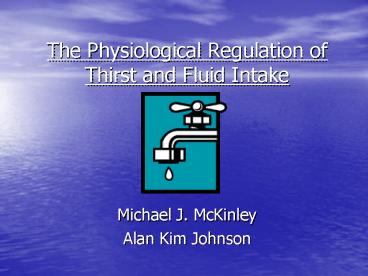The Physiological Regulation of Thirst and Fluid Intake PowerPoint PPT Presentation
1 / 14
Title: The Physiological Regulation of Thirst and Fluid Intake
1
The Physiological Regulation of Thirst and Fluid
Intake
- Michael J. McKinley
- Alan Kim Johnson
2
Why thirst?
- Habitual
- Cultural
- Psychogenic
- Regulatory response
- Reductions in fluid content in bodily
compartments, hypertonicity of extracellular
fluid, increase in dipsogenic hormone
concentration - Maintains volume and composition of body fluids
3
Key Terms
- Hypertonicity high concentration of solutes
- Osmoreceptor sensory receptor that aids in the
regulation of osmotic pressure - Hypovolemia decreased blood/plasma volume due
to dehydration - Circumventricular lie outside blood-brain
barrier - Dipsogenic hormone causes thirst
- Ex. Angiotensin (ANG) II
4
Cerebral Mechanisms
- Hypertonicity, cellular dehydration, and
osmoreceptor stimulation - Hypovolemia and extracellular dehydration
- Angiotensin (ANG) II dipsogenic hormone
- Afferent neural inflow
- Other hormonal signals
- Relaxin
- Atrial natriuretic peptide (ANP)
5
Osmoregulation Intracelluar Dehydration
- 1 2 dehydration ? 1st signal for thirst
- Actually 1 2 increase in osmotic pressure in
plasma - Results from increased concentration of solutes
(i.e. NaCl or sucrose) - Only water, not solutes, cross cell membrane
(osmosis) - Osmoreceptors cause neural cues that initiate
thirst - Hypothalamus
6
- The anterior wall of the third ventricle (AV3V)
was the more likely site for osmotic thirst
regulation and ruled Na concentration as an
initiating factor.
7
Neural Mechanisms Osmotically Stimulated Thirst
- Median preoptic nucleus (MnPO) responds to both
hormonal osmotic stimuli from OVLT SFO - Hormones i.e. relaxin, ANG II
- Osmoregulatory thirst may be blocked by ANG
antagonists in the MnPO. - Ultimately i blood pressure
- MnPO neurons may be osmoreceptive or receive
neural input from other receptive parts of the
brain. - AV3V (lamina terminalis) is the location where
stimuli from circulation, such as increased
solutes or hormones (i.e. ANG II, relaxin),
initiate thirst.
8
(No Transcript)
9
Thirst Extracellular Fluid Volume Deficits
(Hypovolemia)
- Causes hemorrhage, sodium loss, edema
- Endocrine, autonomic, sympathetic nervous
systems all work to maintain critical blood flows
? redistribute blood and interstitial fluids - Eventually deficits must be corrected ? sodium
intake ? thirst - All systems need CNS to receive info regarding
blood condition and/or interstitial volumes for
extracellular fluid regulation. - Both hormonal and visceral afferent pathways.
10
Angiotensin Thirst
- Renin ANG II highly effective thirst inducers
in rats. - ANG-induced thirst requires lamina terminalis to
sense circulating peptides and to use info
derived from the CNS. - The systemic and renin-angiotensin systems are
hypothesized to be functionally coupled in
regards to maintenance of body fluid homeostasis.
11
Thirst Hindbrain Actions
- Baroreceptors (arteries) volume receptors
(atria) in the hindbrain (medulla oblongata)
control BP blood volume - Increases result in inhibition of
osmolarity-deemed thirst - Baroreceptors and volume receptors act as
negative feedback pathway to prevent overdrinking - Decreases result in stimulation of thirst through
initiation in the medulla (then to hypothalamus)
12
Other Humoral Influences on Thirst
- Relaxin stimulates thirst
- Stimulates vasopressin secretion and water
drinking when administered centrally or
systemically - ANGII relaxin work together to stimulate thirst
during pregnancy - ANP inhibits thirst
- Released by cardiac myocytes with high
extracellular fluid volume to inhibit thirst and
vasopressin secretion - Directed mainly against ANG-stimulated drinking
via circumventricular organs in the lamina
terminalis - SFO key site for these hormones
13
Conclusion
- Not just one factor influences thirst.
- Osmotic, ionic, hormonal, nervous signals all
work together w/CNS to regulate - Pathophysiological influences can create
overactivity or insensitivity to fluid loss (i.e.
elderly) - Psychogenic polydipsia -causes water intoxication
- A better understanding of neural pathways may
give insight into the regulation of thirst and
the associated disorders.
14
Sources
- McKinley, M.J., Johnson, A.K. (February 2004).
The Physiological Regulation of Thirst and Fluid
Intake. News in Physiological Sciences. Vol. 19.
www.nips.org. - www.wikipedia.org
- Notes by Dr. Steve Gehnrich

